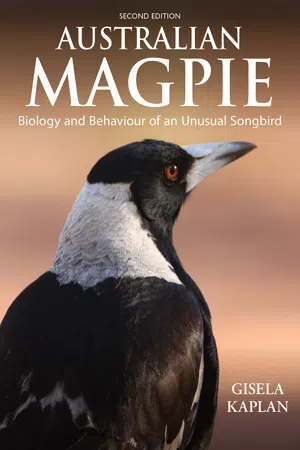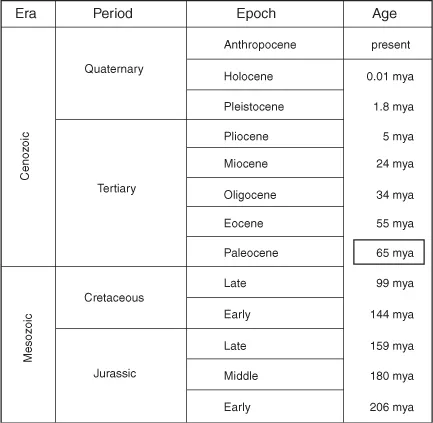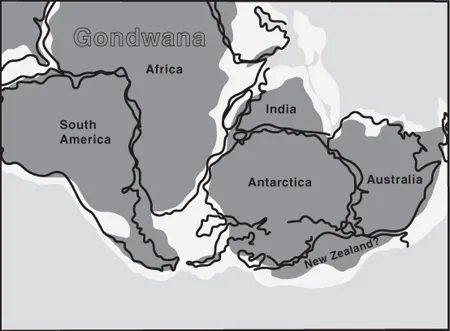![]()
1
Origins
In 2013, a small online article in the Sydney Morning Herald related an enchanting story about the Australian magpie in Aboriginal Dreaming and the creation of daylight. As retold by Hancock1 and Rule2, it was the clever magpie that raised the sky and helped emus to straighten their necks, kangaroos to hop and wombats to leave their burrows because magpies had decided to hold up the sky.
According to the Dreaming, the sky was once so close to the ground that trees could not grow, people had to crawl and all the birds were forced to walk everywhere. The days were dark and cold and one day the magpies decided to hold a meeting on how to end this undesirable situation. They settled on a solution. Working together they managed to prop up the sky with sticks, but it threatened to break the sticks and collapse to Earth again – so they went to higher hills, took a long stick in their beaks and kept pushing the sky higher and higher, until they reached the highest mountain in the whole land. Then, with a special heave, they gave the sky one last push! The sky shot up into the air, and as it rose it split open and a huge flood of warmth and light poured through on to the land below. The animals wondered at the light and warmth, but more at the incredible brightly painted beauty of the Sun-Woman. The whole sky was awash with beautiful reds and yellows. It was the first sunrise.
So that is why, according to this Dreaming, every morning when the Sun-Woman wakes and lights her early morning fire, to this day all the magpies greet her with their beautiful song, perhaps also to remind everyone else of their important role in holding up the sky. The magpie’s song is reflected in its Noongar name koolbardie. The mining town of Coolgardie, Western Australia, means ‘magpie’ in the Goldfields’ Aboriginal dialect.
Fig. 1.1. Ages of the Earth. The Jurassic period (the age of dinosaurs) is the best-known period. The Jurassic period extends from 206 million years ago to 144 mya. The Cretaceous begins 144 and extends to 65 mya when the mass extinction occurred. Latest evidence suggests that at least some of the bird lineages that survived the mass extinction first evolved in the early Cretaceous (meaning that they are older than those arising in the late Cretaceous). The K-T boundary of 65 mya indicates the mass extinction. In the text, reference is usually made to the periods rather than to dates. Most songbirds we know today already existed by the end of the Tertiary period but many birds have gone extinct over the last 100 000 years (during the Holocene Epoch) and, at an accelerated rate, in the newly identified Epoch of the Anthropocene.3
The story is one of many different ones concerned with creation. Notably, magpies play a central and positive role in it, suggesting that magpies have the determination and cognitive ability to resolve problems as we now know, scientifically, they do. This tale (and there are many more about magpies) also confirms the very long-standing relationship humans have had with magpies on this continent.
One might use this tale also as a fitting symbol for the end of the devastating events in geological history: the mass extinction events of ~65 million years ago (mya) (see Fig. 1.1 for detail of the ages of the earth). This particular mass extinction event (there were several before) is thought to have been flood basalt eruptions combined with dramatic falls of sea levels and was followed by a comet (or asteroid) that struck the sea bed near the Yucatan Peninsula in the now Gulf of Mexico ~65/6 mya.
By generating a vapour-rich impact plume, vast amounts of dust particles plunged the world into darkness and cold, inhibiting photosynthesis for many years. It is thought that the consequences of lingering dust completely occluded sunlight for up to six months, thus seriously disrupting continental and marine food chains. This then resulted in the death of most plant life and phytoplankton, which would also kill many of the organisms that depended on them. When the sunlight returned, the Earth had lost 75% of all flora and fauna. The most popularised species among the dramatic losses are the dinosaurs because they left plenty of fossil evidence around the world. Over time, many dinosaur species were also recovered from Victoria (Dinosaur Cove), Queensland (inland Winton, Riversleigh in the north), South Australia (Coober Pedy) and Western Australia (Broome) – testament to their demise also on Australian soil.
Among the 25% of flora and fauna that survived there were also some birds but for a long time it was thought that these had derived from the Northern Hemisphere, somewhere on the Eurasian landmass, seemingly supported by early fossil finds of feathered dinosaurs in Europe and in China.
The lineages of birds that survived did so in East Gondwana, i.e. in Australia.4 Not only is Australia the cradle of all true songbirds5 but, as is slowly being established and confirmed, the cradle of many other avian clades and families as well.6 Diversification of class aves thus seems to have begun during the Cretaceous period.7 The oldest evidence of avian presence in Australia consists of 105 million-year-old fossilised footprints and feather deposits found at Dinosaur Cove on the coast of southern Victoria. The researchers thought that the tracks belonged to a species about the size of a great egret or a small heron.8 It has been suggested that the mass extinction at the end of the Cretaceous period led to a period of recovery, followed by ‘explosive’ speciation.
About 200 mya, Gondwana was a compact supercontinent but eventually broke up over a 150-million-year period (Fig. 1.2). After that, Australia was on its own drifting northwards with a slight counterclockwise direction edging the continent into its current position.
The final confirmation of Australia as the origin of songbirds4,5,9,10,11 has led to many excellent studies and findings but also, more than ever, put Australian birds in a fresh light – native species and subspecies are still being identified and reassigned to this day. It also had to be asked how and when species left Australia to populate other continents. Such questions required a wider context than a within-Australia inquiry.
While this work, at times, may seem distant and abstract to the uninitiated, it has many vast implications, not just to unravel how the evolution of birds actually worked and in which order species evolved but also for the management of species alive today. It may mean, for example, that a species, suddenly declared to fall into several subspecies, i.e. numerically subdivided, may reveal one of its subspecies to be critically underrepresented and thus endangered. This new information can then lead to new conservation management plans. Equally, it is important to know what affects diversification and decline.
Fig. 1.2. Gondwana ~200 mya consisting of many landmasses that now form separate continents or islands but also of those such as much of S and SE Asia (e.g. India, Thailand, Malaya) that floated northwards and now belong to other continents or subcontinents. New Zealand is marked with a question mark because, although known to have been part of Gondwana, for geological reasons has recently been considered as a mini continent. Africa, India and parts of the now Middle East separated first while the link between South America, Antarctica and Australia endured much longer.
This state of flux has affected the magpie as well and in some quite unexpected ways. Since the Australo-Papuan origin of songbirds was internationally confirmed, relationships involving the magpie have been changed several times and in somewhat incompatible ways. To explain this, we can take one brief look at how songbirds may be subdivided (Fig. 1.3). Importantly, there are two superfamilies (to which not all taxonomists subscribe) separating the Passeridae (small songbirds) from corvid-like species, the Corvoidea as shall be explained.
Fig. 1.3 shows only one possible model. When Cracraft and colleagues proposed an avian tree of life, they constructed the phylogenetic relationships among modern birds in such a way that the magpie ended up in a different and unexpected family.6 They classed magpies under a superfamily of bush-shrikes (Malaconotoidea) – No. 29 in Fig. 1.3 below, where it is just listed as a family within the superfamily of Corvoidea. This superfamily contains the bushshrikes (Malaconotidae), helmetshrikes (Prionopidae), ioras (Aegithinidae), vangas (Vangidae) and the Australian butcherbirds, magpies, currawongs and woodswallows (Artamidae). Manegold12 even saw phylogenetic affinities between the vangas (No. 22 in Fig. 1.3) and magpies and a...


